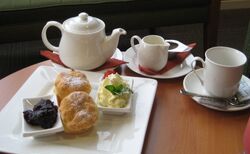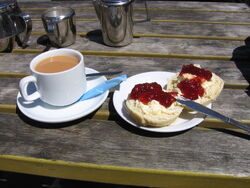
A cream tea (also known as a Devon cream tea (Devonshire tea) or Cornish cream tea)[1] is tea taken with a combination of scones, clotted cream, and jam.
Cream teas are offered for sale in tea rooms throughout the United Kingdom (especially South West England) and the rest of the Commonwealth, or wherever someone wants to give an impression of British influence.
History[]
The name “Devonshire tea” comes from the county of Devon in England,[2] where it is a local speciality. The exact origin of cream tea is disputed, although there is evidence to suggest that the tradition of eating bread with cream and jam already existed at Tavistock Abbey in Devon in the 11th century.[3]
Variations[]

There are regional variations as to how a cream tea should preferably be eaten. The Devonshire (or Devon) method is to split the scone in two, cover each half with clotted cream, and then add strawberry jam on top. Traditionally, it is important that the scones be warm (ideally, freshly baked), and that clotted (rather than whipped) cream and strawberry jam, rather than any other variety, are used. Butter is generally not included, and the tea should be served with milk.[4]
In Cornwall, the cream tea was traditionally served with a “Cornish split”, a type of slightly sweet white bread roll, rather than a scone.[5]
It is now rare to find this available commercially, even in Cornwall, although splits are still used by many Cornish families in their own homes. The warm roll (or scone) is first buttered, then spread with strawberry jam, and finally topped with a spoonful of clotted cream. Scones are rarely buttered in commercially available teas.
Where clotted cream is not available, whipped cream is sometimes used as a substitute.
Another variation to a cream tea is called “Thunder and Lightning”, which consists of a round of bread, topped with clotted cream and golden syrup, honey, or treacle.[1]
Protected status[]
In May 2010, a campaign was launched at the Devon County Show to have the name Devon cream tea protected within the European Union under Protected Designation of Origin (PDO) rules. The campaign was launched following discussion on BBC Radio Devon.[6]
See also[]
References[]

|
This page uses content from Wikipedia. The original article was at Cream tea. The list of authors can be seen in the page history. As with WikiTea, the text of Wikipedia is available under the Creative Commons Licence. |
- ↑ 1.0 1.1 Salmans, Sandra. “Britain’s Best at Teatime,” The New York Times. September 5, 1982.
- ↑ Although in England the geographical area is now generally known as Devon rather than Devonshire, the latter term is more commonly used in this context in other parts of the world.
- ↑ “Were cream teas ‘invented’ in Tavistock?” BBC. 17 January 2004.
- ↑ BBC - h2g2 - Cream Teas
- ↑ O'Brien, Harriet. “Cornwall: a clean break,” The Independent. 8 July 2006.
- ↑ “Devon cream teas could get EU protected status,” BBC News. 19 May 2010.
Further reading[]
- Smillie, Susan. “It’s scone wrong,” The Guardian. 20 May 2010.
- Kirby, Terry. “Jam or cream first? The great scone debate …” London Evening Standard. 6 November 2009.
- “How do you take your cream tea?” BBC Cornwall. 9 June 2010.
